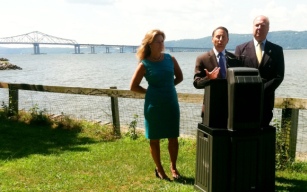County executives from Westchester, Rockland, and Putnam counties announced their support for Governor Andrew Cuomo’s Tappan Zee Bridge project yesterday, clearing the way for the project to seek federal funding. The executives, who had withheld support until now, received two concessions: A guarantee of rush hour bus lanes on the new bridge, and the creation of a Regional Transit Task Force, which will report back in one year with recommendations for transit connections to the bridge. They also announced the creation of a working group that would focus on project financing and bridge tolls.

With this move, Westchester County Executive Rob Astorino, Rockland County Executive Scott Vanderhoef and Putnam County Executive MaryEllen Odell have cleared the way for a unanimous vote in support of the Tappan Zee project at the New York Metropolitan Transportation Council. NYMTC approval is required for federal sign-off on the project.
While yesterday's announcement signals a new stage in the Tappan Zee saga, major questions remain about the state's commitment to improving transit on the Rockland-Westchester I-287 corridor, and about the bridge's shaky finances.
In a statement, Gov. Cuomo did not mention bus lanes, the transit task force or the financing working group, but simply thanked the county executives for their support. Yesterday's announcement came after a flurry of endorsements by other elected officials trumpeted by the Cuomo administration.
One thing that's certain now is that the "emergency access lanes" on the new bridge will be used as rush-hour bus lanes (despite an earlier promise from the Cuomo administration, this had remained in doubt until yesterday.) An open question is how the bridge's bus lanes would connect to roadways on either side, though there are some hints. According to Rockland County Department of Planning spokesperson Susan Meyer, yesterday's agreement does not involve “altering the bridge design or creating something new. We’re talking about using what we have.” This could include letting buses use the Thruway shoulder to reach the Palisades Center mall, on the Rockland County side of the bridge, and reusing an access ramp near the bridge for bus connections to Tarrytown, on the Westchester side.
Work on transit infrastructure improvements on either side of the bridge will have to wait at least a year, after the bridge is scheduled to begin construction. That's when the new Regional Transit Task Force, announced yesterday, reports back with its recommendations. It’s not yet clear who will be appointing task force members, or how various government and advocacy interests will be represented.
The transit task force will look at commuter rail and BRT along portions of the I-287 corridor, with recommendations that could be implemented immediately as well as a longer-term look at the regional transit network. However, the task force is no substitute for the detailed transit planning process that the Cuomo administration abandoned last year. It's unlikely the task force will examine a larger, regional BRT system like the one that had been considered under previous governors.
The Tri-State Transportation Campaign greeted yesterday's news with caution, while calling the commitment to rush-hour bus lanes “a real victory.”
“Construction, at a minimum, is going to take five years,” said executive director Veronica Vanterpool. “There’s still some time, theoretically, to incorporate whatever outcomes or recommendations will come from this task force.” After the task force makes those recommendations, TSTC wants the state to implement low-cost improvements that bring BRT service to the counties on either side of the Tappan Zee. “A system requires more than just a 3.1 mile bus lane on a bridge,” Vanterpool said.
In addition to the transit agreement, the county executives made two announcements that aim to deal with the project's high costs. The emphasis, however, is on keeping tolls down, not avoiding the financial death spiral scenario, in which people who never use the bridge -- including MTA fare-payers -- end up subsidizing its construction.
The first measure is the creation of “a working group of Thruway, state, federal and local officials” to seek ways to minimize toll increases through federal support, toll discounts for local residents and reductions in borrowing costs. The exact membership of the working group remains unknown. It comes a week after Gov. Cuomo asked the Thruway Authority to create a committee to reduce the project's cost.
The second cost-cutting announcement was even more opaque. “Incentives will be created,” the county executives said, “for contractors that could be used to reinvest in regional mass transit or to moderate impact on toll-payers.” The exact nature of these incentives, which are usually structured to move up project completion dates, will be negotiated after a final bidder is selected to design and build the bridge. The balance of toll reduction and transit investment that might occur as a result of these incentives is also yet to be determined.
In the end, these measures are unlikely to significantly reduce the bridge's $5.2 billion dollar price tag. As the project moves forward, watchdogs will have to keep an eye on the complex financing of the bridge. The political pressure to keep tolls down could exacerbate a situation where Tappan Zee drivers don't cover the full cost of the bridge, and other New Yorkers have to pay to make up the difference.





